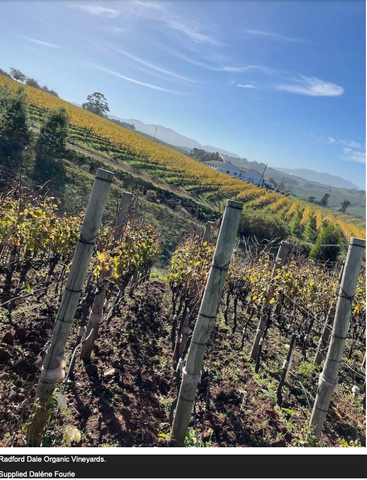A LITTLE BACKGROUND | Gamay: The Antidote
Article first published on 11 May 2023 by Daléne Fourie, for News24

• Radford Dale is the first SA winery in 20 years to cultivate and plant the light red Beaujolais variety Gamay in South Africa.
• In October 2021, they purchased a 20ha organically certified farm in Elgin, previously named Elgin Ridge, and now Radford Dale Organic.
• Here they have found a home after 24 years of operating as a virtual winery. They plan to introduce Gamay as a champion of South African terroir and build their ranges around it and their organic practices.
Did you know? There is only about 7.02ha* of Gamay in South Africa. Most of it owned by Radford Dale.
R&D stands for Research and Development. A business term that denotes the gathering of knowledge/information to create a new product or discover new ways to improve existing products and services. RD can also stand for Radford Dale (quite serendipitously for me), a wine company that was a virtual winery in South Africa before it was trendy to do so. They adopted the Burgundian model of sourcing grapes from standout vineyards and produced showstopping wines in their Stellenbosch cellar.
Established by Ben Radford and Alex Dale in 1998, they now have three international investors from the UK, Australia, and France, as well as local partners Heather Whitman, Kathleen Krone, Andy Openshaw, and Jacques de Klerk (also head of their Viticulture and Winemaking). Their international scope is reflected in their shareholders and their thriving imports business, simply named Radford Dale Imports, which brings in below-the-radar (and very much on the radar) wines from France, Australia, America, and New Zealand. At their core, the two businesses represent a valuable asset in understanding South African wine in context to the world and, in turn, using that information to make the best South African terroir-driven wines. R&D.

42
In the Hitchhiker's Guide to the Galaxy, the Deep Thought Computer said the answer to life, the universe, and everything is 42.
Radford Dale has taken 24 years (25 years this year, but it doesn't work with my analogy) to mull over the question of South African wine and has arrived at a two-part answer: Organic Farming and Gamay.
If you look at Radford Dale's various wine ranges over the years, you'd be forgiven for being a bit confused. After all, they farmed over 37 different vineyards from Stellenbosch, Elgin, Stanford, the Swartland, Voor-Paardeberg, and Paarl.
With a variety of ranges entangled in the pursuit, from the Winery of Good Hope (which was the original umbrella company), the Radford Dale Range, Thirst, Vinum, Land of Hope and Black Rock - I'm sure I missed a few, but this is merely to demonstrate the grand scope of their interest.
The grand scope of what is possible in South Africa. During this time, Jacques also became enamoured of natural wine, think minimal interference, skin contact, sediment, sometimes volatile, but always in pursuit of a true reflection of site. Now, I'm not slating natural wine. There is a place for it in the industry, but it has also informed the current Radford Dale wine ranges. Jacques says that while he loves natural wine, he also learned that there was a certain way the grapes wanted to be treated to best express a site—thus, natural wine 2.0.

The Parker era
The fine wine world in the 80s was run by people like Robert Parker (now a retired US wine critic) and Michel Rolland (a Bordeaux-based oenologist who consults for several wineries still), people who were known for liking and rewarding big, extracted, high alcohol, 200% New Oak, wines. Meal-in-a-glass-wines.
These wines could come from anywhere. There was so much emphasis placed on the actual winemaking that the sense of place was mostly obscured by toasted oak and aggressive punch downs.
A few of Radford Dale's original wines, like the Frankenstein Pinotage and the Antidote Gamay noir, are named in defiance of these over-extracted, over-done wines. In contrast, these site-specific, minimal invention, made-in-the-vineyard wines, their proposed cure to what the wine world called the Parker-era (poor Robert, he just liked what he liked).

Gamay
Over 24 years of experience in the SA wine industry, forging relationships with the South African growers, discovering and rediscovering the special pockets of earth and vines. Given that background, it only makes sense that they would try their hand at establishing a grape variety they think could make world-class wine here (you know, if they didn't find anything comparable).
Enter Gamay. Now Gamay hasn't been planted in South Africa for over 20 years, though back in the day, it was a firm favourite to augment the colour and acidity of a Cabernet or a Pinot Noir - before we knew where to plant Pinot Noir.
Gamay is the grape of Beaujolais, the French wine region known for its Beaujolais Nouveau released on the third Thursday of November, direct from harvest - a light red whose reputation was tarnished by this early much-commercialised release, but who in recent years has come to showcase its absolute versatility and elegance when planted on the right soils, in the right terroir. The Crus of Beaujolais are proof of this.
You can try anything from St-Amour, Juliénas, Chénas, Moulin-à-Vent, Fleurie, Chiroubles, Morgon, Regnié, Brouilly, and Côte de Brouilly (roughly in order from north to south). After all, Neal Martin writes in his recent article on their 2020-2022 releases: "The future is Beaujolais." Though a highly contested statement, the key factors that make this wine so great are its diminutive price point (in comparison to Burgundy's Pinot Noir), its supply, and the fact that Beaujolais has figured out how to make it in a serious, elegant style with longevity to boot.

An unwilling convert
What turned Jacques onto the versatility of Gamay was when he tasted a Domaine Jean Foillard Morgon 'Cote du Py'. He said it tasted like Pinot. And when he tasted a Dominique Piron Chena Quartz, it tasted like Syrah, like a St. Joseph. That, coupled with the fact that Gamay loves granite (and we have granite) and heat, set the scene.
I'm always impressed by people who plant things for the first time without any idea of whether it will work but invest for the sheer opportunity to make something new, potentially better, and for future generations. Now, it has to be said I was an unwilling convert. I love Cinsault. After all, I have tasted Ian Naudé's Werfdans, and Alex Milner's Stellenbosch and Darling Cinsault, and I have had Tamlyn Currin's words tattooed on my brain (not my arm, don't worry, Mom).
I believe it is South African, and I imagine the Turkish delight, the cuts, and the bare earth when I taste it. *Jis, I'm dramatic.
And so, I was unwilling to let this 7.02ha, upstart Beaujolais light red grape make me question my commitment to Cinsault. But it did. Only until I was able to convince myself that they weren't fighting the same fight.
There is a place for old vine South African Cinsault and, in fact, for young vine Cinsault, too, as there is a place for Pinot Noir. The thing with Pinot Noir is that it only likes what it likes and is therefore limited in where it will live and survive. Cinsault has heritage and a different flavour profile - think alpine strawberries, rose water, and sour cherry. While Gamay is refined, floral, subtly earthy, round, and utterly delicious. A Frenchman in Africa, but a hardy one.

Stokkies
To make Gamay, Radford Dale had to grow it. Jacques talks about a viable agricultural asset. They first took cuttings from the original mother block Grondves in the Polkadraai Hills and cultivated 0.8ha of new Gamay stokkies on Jozua Joubert's unicorn site, Karibib. I've told you about Karibib before. South-east-facing granite, with a view of False Bay, prime vine country, especially for Gamay.
While they only lease the land, they cultivated and paid for these stokkies. They currently manage this vineyard and the original Polkadraai vineyard to make their Thirst, Vinum, and Antidote Gamays. Jacques says the difference is in the ripeness of the picking first and then the treatment in the cellar. The Thirst is a GlouGlou wine, which, as the onomatopoeia suggests, is a gluggable, affordable wine, but elegant and round as Gamay has taught me he can be. The Vinum forms part of their beautiful site-specific range and explores the versatility of the grape in more detail, while the Antidote represents the pinnacle of what they have been able to accomplish with this decidedly NEW grape in Africa.
Yet, because the original vineyard is basically on life-support while the new Karibib vines are slowly coming into their own. As Jacques described it, they were making three wines from two vineyards while the earth was constantly shifting below them - they needed a vineyard of their own.
Radford Dale Organic
They found the little 20-ha farm in Elgin, on the Appletiser road, originally named Elgin Ridge, owned by Brian and Marion Smith. Brits with a specific focus on Biodynamic and Organic practices. It was one of only two certified biodynamic and organic wine producers when I visited them in 2018. Marion had established the Biodynamic and Organic Wines of South Africa association to keep the farmers honest when declaring their certification.
The thing about biodynamic and organic certification is that it is expensive, and many farmers only employ some practices in the vineyard, unable to afford full certification nor risk losing a vintage while the soil is rehabilitated. Jacques said he went to Marion and Brian hoping to buy grapes just before Covid.
They declined but offered him the farm instead. Now named Radford Dale Organic, they took over the farm in October of 2021, having tested the organic farming model for a year as a pilot project on their rented vineyards in Stellenbosch.
What they got with Elgin Ridge is a farm that didn't have to be rehabilitated to their organic practices, with rolling hills, different aspects, and soils to play and experiment with, as is their way. Here they have just planted 1 ha Gamay, currently faintly reminiscent of Groot from Guardians of the Galaxy when he was little. And plan to add another ha next year.
In total, they have 8.5 ha of vines in the ground, including a labour-intensive high-density planting of Chardonnay and Pinot Noir for their Organic Range (consisting of a Chardonnay and Pinot Noir, and a Semillon and Cabernet Franc to come later this year), and plan to add another 3.5ha this year.

Rising tide
Jacques says he'd love to see what a Gamay from the Swartland would taste like, and Hemel-en-Aarde. In the end, they're not just doing this for themselves but for South Africa. If they can rediscover and reinvigorate a variety that not only likes the shifting climactic conditions, loves granite, and lends itself to producing world-class wine. And they can offer more producers the plant material to experiment with. Well then, we all win.
I invite you to try these wines. The Vinum and Thirst are under R200 and are seriously worth your time. Shop direct here.
*According to SAWIS Status of Red Cultivars 2022







